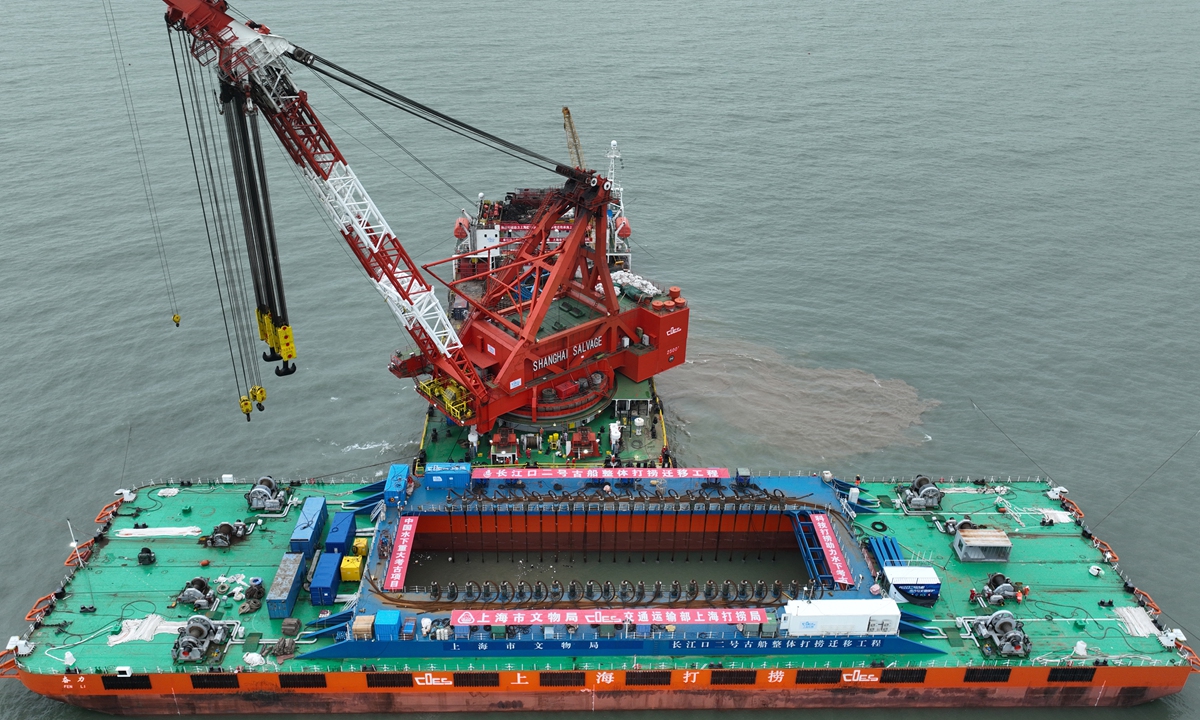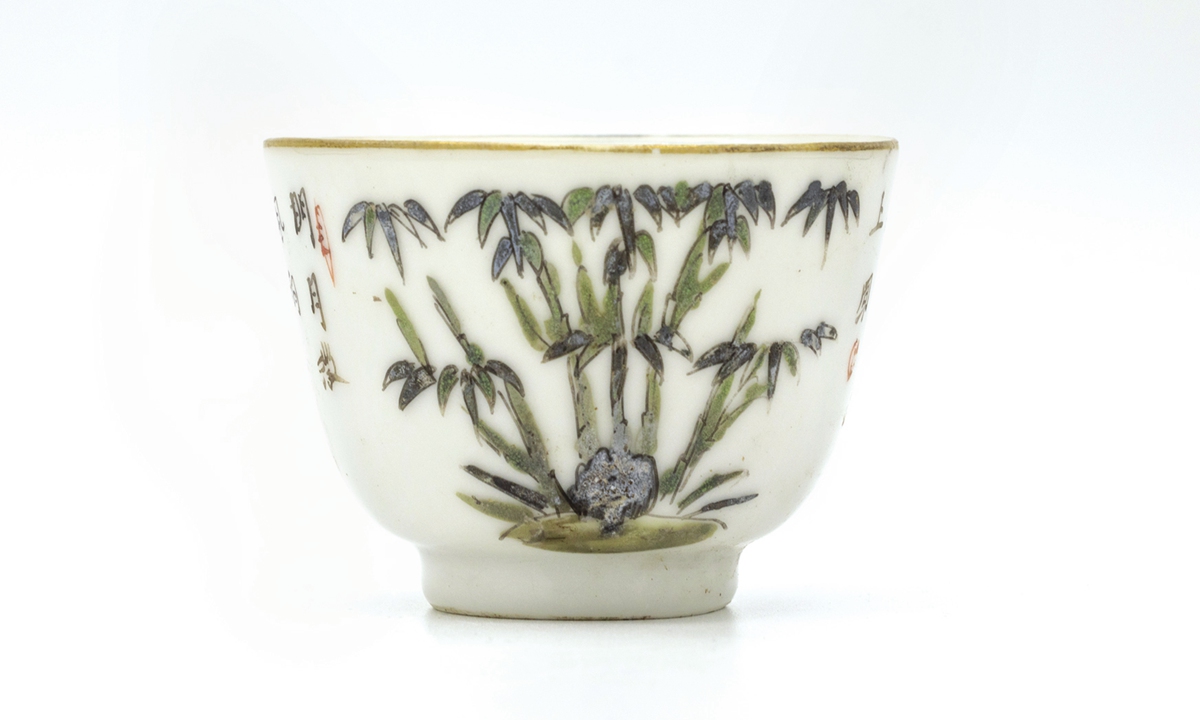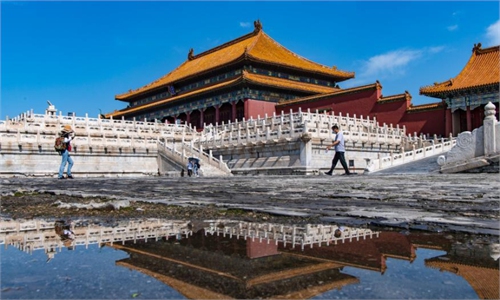ARTS / CULTURE & LEISURE
Ancient shipwreck sees light of day again, a major milestone for Chinese underwater archaeology
Coming to the surface

The salvage site in the Yangtze River Photo: Courtesy of China National Cultural Heritage Administration

A porcelain cup found in the shipwreck Photo: Courtesy of China National Cultural Heritage Administration

A model of the ancient shipwreck Photo: Courtesy of China National Cultural Heritage Administration
On Monday, as a shipwreck was slowly pulled out of the water from the bottom of a riverbed where it had been laying for more than a century and a half, Chinese archaeology witnessed a new breakthrough in the field of underwater archaeology. The salvage operation took nearly three hours to remove the shipwreck along with a large caisson, a watertight chamber that had been built specially for the wreck's removal.In a few days, the ancient shipwreck is expected to be shipped to the former site of the Shanghai Shipyard, where further research and preservation efforts will be carried out.
The shipwreck, dubbed the Yangtze River Estuary No.2, is one of the largest and best-preserved ancient wooden shipwrecks ever discovered in China and even the world. The ship was filled with a diverse array of cultural relics that are sure to prove valuable for research into the ships of the late Qing Dynasty (1644-1911).
The excellent condition of the ship and the rich cultural relics on board are of great significance for research into the history of shipbuilding, the shipping industry and ceramic production in China and the world, a spokesperson from the China National Cultural Heritage Administration told the Global Times on Monday.
The technology used to salvage the ancient shipwreck is also significant, as it marks the first use of a creative technical solution specifically designed to transfer the ship in its entirety.
Ancient shipping trade
Experts noted that over the past 30 years underwater excavations in China such as the salvaging of Huaguang Reef 1, Coral Island 1 and other important shipwrecks have demonstrated the prosperity of the ancient Maritime Silk Road.
Experts said that the merchant ship dates back to the reign of the Qing Dynasty Tongzhi Emperor (1862-1875). It sat 5.5 meters below the water surface on a shoal on the northeast tip of Hengsha Island in the Chongming district of Shanghai.
The ship was about 38.1 meters long and 9.9 meters wide at its broadest point. A total of 31 cargo chambers were discovered and its main body is quite complete, including the prow and bollards on the port and starboard sides.
Since the shipwreck was discovered in 2015, four cabins have been carefully cleared, revealing more than 600 cultural relics such as blue and white porcelain wares from the "porcelain capital" Jingdezhen in East China's Jiangxi Province as well as purple clay objects and hookah pots made in Vietnam.
The underwater archaeology team found porcelain wares from the Yuan Dynasty (1279-1368) and a complete blue and white vase with bean-green glaze that stands 60 centimeters in height. Experts say this style of the vase was popular in the late Qing Dynasty and the early years of the Republic of China (1912-49) and were mainly used as dowry gifts.
To their surprise, a total of 50 blue and white cups with dragon decorations were removed from inside as the archaeologists cleaned and cleared away the thick layers of mud from the vase.
Following preliminary research, a vivid picture of the shipping trade and life on board a merchant ship in the late Qing Dynasty slowly began to unfold.
Experts believe that the objects were mostly meant for trade in the early days when Shanghai was an open port along the historic Maritime Silk Road.
Technological breakthroughs
As one of the most significant underwater archaeological excavation projects in China, the salvage operation removed the shipwreck from the riverbed using 22 giant arched steel beams, which formed a caisson 48 meters long, 19 meters wide, 9 meters deep. The entire caisson with the ship inside, weighing a total of 8,800 tons, was then lifted from the river.
In this way, the cranes doing the heavy lifting did not need to touch the wreck directly, thereby reducing the risk of damage to the ship.
Other conditions in the river also posed a problem during the planning stage.
As the water at the mouth of the Yangtze River has nearly zero visibility, locating the entire shipwreck was like looking for a needle in a haystack. Such cloudy environments pose a bottleneck for underwater excavations around the world.
Researchers have made some more breakthroughs for Chinese archaeology by developing remote equipment that allows them to gather underwater images through the muddy water and determine the condition of the shipwreck.
The use of "underwater robots" greatly improved the safety of researchers working in the risky environment as well as increased the overall efficiency of the archaeological excavation, Yang Yimin, an expert in archaeology technology at the University of Chinese Academy of Sciences, told the Global Times.
Also a Chinese ceramics expert, Yang emphasized that the use of technology in archaeology is a "destined" direction for the field in China.
"Not only for ship salvaging, the precious ceramics found underwater must also be analyzed to define their age and origin and then restored using the aid of advanced technology."
"China saw the potential of high technology in archaeology back during projects in the 1990s like the Xia Shang Zhou Chronology Project and even earlier back in the 1960s," Yang noted.




